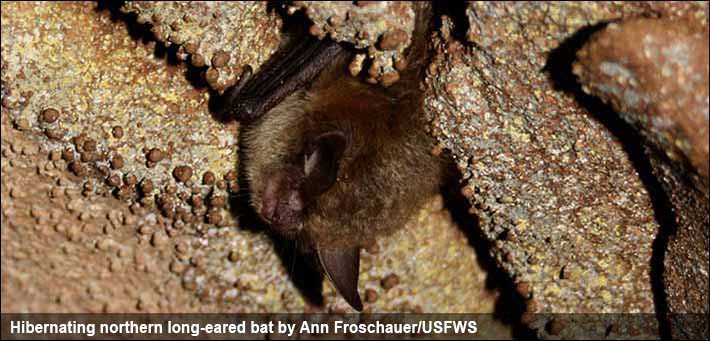Connect With Us
|
Northern Long-Eared Bat (Myotis septentrionalis)Status: Threatened with 4(d) RuleThe northern long-eared bat is one of the species of bats most impacted by the disease white-nose syndrome. Due to declines caused by white-nose syndrome and continued spread of the disease, the northern long-eared bat was listed as threatened under the Endangered Species Act on April 2, 2015. We also developed a final 4(d), which published in the Federal Register on January 14, 2016. The 4(d) rule specifically defines the "take" prohibitions. 
Northern long-eared bat with symptoms of white-nose syndrome. Photo by Steve Taylor; University of Illinois
Bats are important to our nation’s ecology and economy, eating tons of insects nightly and providing a natural benefit to farmers and foresters. Some research estimates that bats provide at least $3 billion annually in economic value.
Status: Threatened: April 2, 2015 Final 4(d) Rule: January 14, 2016
Habitat: Hibernates in caves and mines - swarming in surrounding wooded areas in autumn. During late spring and summer roosts and forages in upland forests.
Lead Region: 3
Region 3 Lead Office: Twin Cities Field Office
Range: Alabama, Arkansas, Connecticut, Delaware, the District of Columbia, Georgia, Illinois, Indiana, Iowa, Kansas, Kentucky, Louisiana, Maine, Maryland, Massachusetts, Michigan, Minnesota, Mississippi, Missouri, Montana, Nebraska, New Hampshire, New Jersey, New York, North Carolina, North Dakota, Ohio, Oklahoma, Pennsylvania, Rhode Island, South Carolina, South Dakota, Tennessee, Vermont, Virginia, West Virginia, Wisconsin, and Wyoming.
Summer Survey Guidance - the Indiana bat 2015 Summer Survey Guidance can be used for northern long-eared bat presence/probable absence surveys for the 2015 field season.
Section 7 consultation for projects that fit under 4(d) rule
WNS Zone Map - this map is updated on the first of every month if there are new counties with verified occurrences of white-nose syndrome or Pseudogymnoascus destructans (Pd), the fungus that causes the disease.
Northern Long-eared Bat Images
Critical Habitat Determination Not Prudent (April 27, 2016)We have determined that designating critical habitat for the northern long-eared bat is not prudent. Northern long-eared bat summer habitat is not limited or in short supply and summer habitat loss is not a range-wide threat to the species. Designating critical habitat in the areas where it summers would not benefit the northern long-eared bat, and therefore, would not be prudent. Winter habitat does have specific physical and biological features that are essential to the conservation of the species, and, therefore, meets the definition of critical habitat. However, information became available demonstrating that designating critical habitat would likely increase vandalism, disturbance, and, potentially, the spread of white-nose syndrome in the caves and mines where northern long-eared bats hibernate. Therefore, we determined that it is not prudent to designate winter habitat as critical habitat.
Final 4(d) Rule - Jan. 14, 2016Section 4(d) of the Endangered Species Act directs the Service to issue regulations deemed “necessary and advisable to provide for the conservation of threatened species.” It allows the Service to promulgate special rules for species listed as threatened (not endangered) that provide flexibility in implementing the ESA. We use 4(d) rules to target the take prohibitions to those that provide conservation benefits for the species. This targeted approach can reduce ESA conflicts by allowing some activities that do not harm the species to continue, while focusing our efforts on the threats that make a difference to the species’ recovery.
Federal Register Final 4(d) Rule
Briefing Slides: About the 4(d) Rule (PDF)
NEW! Section 7 Consultation for Federal Projects that fit under the 4(d) Rule
Key to the 4(d) Rule for Non-federal Projects
Hibernacula and Maternity Roost Tree Locations
WNS Zone Map (1-page PDF Map updated August 31, 2016. The WNS Zone map is updated on the first of every month if there are new counties with verified occurrences of white-nose syndrome or Pseudogymnoascus destructans (Pd), the fungus that causes the disease.
Counties in WNS Zone (Excel Spreadsheet) Updated July 28, 2016. Counties in the WNS Zone are updated on the first of every month if the zone changes due to new counties verified with white-nose syndrome or Pseudogymnoascus destructans (Pd), the fungus that causes the disease.
Counties in Northern Long-eared Bat Range (Excel Spreadsheet) Updated July 28, 2016. NewsNews Release (April 25, 2016): Critical Habitat is Not Prudent
April 12, 2016: Indiana Bat Summer Survey Guidelines Available
News Release (March 30, 2016): Searching for the Northern Long-eared Bat at Unexpected Places About Northern Long-eared BatsThe northern long-eared bat is found in the United States from Maine to North Carolina on the Atlantic Coast, westward to eastern Oklahoma and north through the Dakotas, even reaching into eastern Montana and Wyoming. In Canada it is found from the Atlantic Coast westward to the southern Yukon Territory and eastern British Columbia.
Species Profile (Petitions, status reviews and conservation documents)
Northern Long-eared Bat Images on Flickr
Section 7 ConsultationSection 7 Consultation for Federal Projects that fit under the 4(d) Rule
Biological Opinions - final Biological Opinions for federal actions that may affect northern long-eared bats
Section 7 Technical Assistance Website - explains section 7 of the Endangered Species Act and provides step-by-step instructions for the consultation process.
Programmatic Consultation with Federal Transportation Agencies
About Bats
White-nose Syndrome. org: A Coordinated Response to the Devastating Bat Disease
White Nose-Syndrome Fact Sheet (June 2014) (2-page PDF
Bat Box Fact Sheet Minnesota | Indiana | Wisconsin
Economic Importance of Bats in Agriculture (Science 1 April 11)
ArchivesArchived Documents and Information Materials from Previous Federal Actions
Midwest Endangered Species Home National Endangered Species Home
|
||||||||||||
Last updated:
September 2, 2016
|
|||||||||||||





